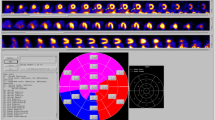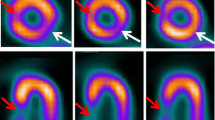Abstract
Background
The SMARTZOOM multifocal collimator from Siemens Healthcare was developed to improve the γ-photon sensitivity in myocardial perfusion imaging without truncating the field of view. As part of the IQ-SPECT package, it may be used to reduce radiopharmaceutical dose to patients, as well as acquisition time. The aim of this study was twofold: (1) to evaluate the influence of dose reduction in semi-automated MPI scoring, with focus on different strategies for the choice of normal data (count-matched, full-count), and (2) to evaluate the effect of dose reduction afforded by Siemens’ IQ-SPECT package.
Methods
50 patients underwent Tc-99m-sestamibi one-day stress/rest SPECT/CT. Multiple levels of count reduction were generated using binomial thinning. Using Corridor 4DM, summed stress score (SSS) was calculated using either count-matched or full-count normal data. Studies were classified as low-risk (SSS < 4) or intermediate/high-risk (SSS ≥ 4).
Results
Count reduction using count-matched normal data increases false-normal rate and decreases sensitivity. With full-count normal data, count reduction increases false-hypoperfusion rate, leading to decreased specificity. Altogether, rate of reclassification was significant at roughly 67% dose and below.
Conclusion
Significant bias results from count level of normal data relative to actual patient data. Compared to standard LEHR, IQ-SPECT should allow for significant dose reduction.







Similar content being viewed by others
Notes
As noted above, reducing dose is not strictly the same as imaging time, as physiological factors such as tracer kinetics and patient motion will differ between the two cases. Nevertheless, from the perspective of counts acquired, the two processes may be considered equivalent.
For example, Caobelli et al46 had a time interval of approximately three minutes between the SPECTs, which should render tracer kinetics to be negligible.
Abbreviations
- MPI:
-
Myocardial perfusion imaging
- TPD:
-
Total perfusion deficit
- SSS:
-
Summed stress score
- SRS:
-
Summed rest score
- AT:
-
Acquisition time
- IT:
-
Imaging time
- CPP:
-
Counts per pixel
References
Zheng ZJ, Croft JB, Giles WH, Mensah GA. Sudden cardiac death in the United States, 1989 to 1998. Circulation. 2001;104:2158–63.
Hachamovitch R, Berman DS, Shaw LJ, Kiat H, Cohen I, Cabico JA, et al. Incremental prognostic value of myocardial perfusion single photon emission computed tomography for the prediction of cardiac death: differential stratification for risk of cardiac death and myocardial infarction. Circulation. 1998;97:535–43.
Underwood SR, Anagnostopoulos C, Cerqueira M, Ell PJ, Flint EJ, Harbinson M, et al. Myocardial perfusion scintigraphy: the evidence. Eur J Nucl Med Mol Imaging. 2004;31:261–91.
Hendel RC, Berman DS, Di Carli MF, Heidenreich PA, Henkin RE, Pellikka PA, et al. Appropriate use criteria for cardiac radionuclide imaging. J Am Coll Cardiol. 2009;53:2201–29.
Hutton B. The origins of SPECT and SPECT/CT. Eur J Nucl Med Mol Imaging. 2014;41:3–16.
Okada RD, Glover D, Gaffney T, Williams S. Myocardial kinetics of technetium-99m-hexakis-2-methoxy-2-methylpropyl-isonitrile. Circulation. 1988;77:491–8.
Dorbala S, Di Carli MF, Delbeke D, Abbara S, DePuey EG, Dilsizian V, et al. SNMMI/ASNC/SCCT guideline for cardiac SPECT/CT and PET/CT 1.0. J Nucl Med. 2013;54:1485–507.
Hesse B, Tagil K, Cuocolo A, Anagnostopoulos C, Bardies M, Bax J, et al. EANM/ESC procedural guidelines for myocardial perfusion imaging in nuclear cardiology. Eur J Nucl Med Mol Imaging. 2005;32:855–97.
de Jong MC, Genders TS, van Geuns R-J, Moelker A, Hunink MM. Diagnostic performance of stress myocardial perfusion imaging for coronary artery disease: a systematic review and meta-analysis. Eur Radiol. 2012;22:1881–95.
Lindner O, Bengel FM, Hacker M, Schäfer W, Burchert W. Use of myocardial perfusion imaging and estimation of associated radiation doses in Germany from 2005 to 2012. Eur J Nucl Med Mol Imaging. 2014;41:963–71.
Duvall WL, Croft L, Godiwala T, Ginsberg E, George T, Henzlova M. Reduced isotope dose with rapid SPECT MPI imaging: Initial experience with a CZT SPECT camera. J Nucl Cardiol. 2010;17:1009–14.
Bocher M, Blevis IM, Tsukerman L, Shrem Y, Kovalski G, Volokh L. A fast cardiac gamma camera with dynamic SPECT capabilities: design, system validation and future potential. Eur J Nucl Med Mol Imaging. 2010;37:1887–902.
DePuey EG. Advances in SPECT camera software and hardware: currently available and new on the horizon. J Nucl Cardiol. 2012;19:551–81.
Vija AH, Malmin R, Yahil A, Zeintl J, Bhattacharya M, Rempel TD et al. A method for improving the efficiency of myocardial perfusion imaging using conventional SPECT and SPECT/CT imaging systems. In: Nuclear Science Symposium Conference Record (NSS/MIC), 2010 IEEE; 2010. p. 3433-7.
Zeintl J, Rempel TD, Bhattacharya M, Malmin RE, Vija AH. Performance characteristics of the SMARTZOOM collimator. In: Nuclear Science Symposium and Medical Imaging Conference (NSS/MIC), 2011 IEEE; 2011. p. 2426-9.
Erwin WD, Jessop AC, Mar MV, Macapinlac HA, Mawlawi OR. Qualitative and quantitative comparison of gated blood pool single photon emission computed tomography using low-energy high-resolution and SMARTZOOM collimation. Nucl Med Commun. 2017;38:35–43.
Pirich C, Keinrath P, Barth G, Rendl G, Rettenbacher L, Rodrigues M. Diagnostic accuracy and functional parameters of myocardial perfusion scintigraphy using accelerated cardiac acquisition with IQ SPECT technique in comparison to conventional imaging. Q J Nucl Med Mol Imaging. 2017;61:102–7.
Caobelli F, Pizzocaro C, Paghera B, Guerra UP. Evaluation of patients with coronary artery disease. IQ-SPECT protocol in myocardial perfusion imaging: Preliminary results. Nuklearmedizin. 2013;52:178–85.
Lyon MC, Foster C, Ding X, Dorbala S, Spence D, Bhattacharya M, et al. Dose reduction in half-time myocardial perfusion SPECT-CT with multifocal collimation. J Nucl Cardiol. 2016;23:657–67.
Havel M, Kolacek M, Kaminek M, Dedek V, Kraft O, Sirucek P. Myocardial perfusion imaging parameters: IQ-SPECT and conventional SPET system comparison. Hell J Nucl Med. 2014;17:200–3.
Novak M, Grancorvitz A, Johnson C. Comparison of IQ-SPECT/CT with conventional SPECT/CT for myocardial perfusion imaging. J Nucl Med. 2012;53:2712.
Erwin W, Jessop A, Peirsol W, Mar M, Jones S, Macapinlac H, et al. Qualitative and quantitative comparison of gated blood pool SPECT using low-energy high-resolution and SMARTZOOM collimation. J Nucl Med. 2014;55:1736.
Matsuo S, Nakajima K, Onoguchi M, Wakabayash H, Okuda K, Kinuya S. Nuclear myocardial perfusion imaging using thallium-201 with a novel multifocal collimator SPECT/CT: IQ-SPECT versus conventional protocols in normal subjects. Ann Nucl Med. 2015;29:452–9.
Du Y, Bhattacharya M, Frey EC. Simultaneous Tc-99m/I-123 dual-radionuclide myocardial perfusion/innervation imaging using Siemens. Phys Med Biol. 2014;59:2813.
Henzlova MJ, Duvall WL, Einstein AJ, Travin MI, Verberne HJ. ASNC imaging guidelines for SPECT nuclear cardiology procedures: Stress, protocols, and tracers. J Nucl Cardiol. 2016;23:606–39.
Holly TA, Abbott BG, Al-Mallah M, Calnon DA, Cohen MC, DiFilippo FP, et al. Single photon-emission computed tomography. J Nucl Cardiol. 2010;17:941–73.
Bundesamt für Strahlenschutz. Bekanntmachung der aktualisierten diagnostischen Referenzwerte für nuklearmedizinische Untersuchungen [National Regulation]. Bundesanzeiger. 2012;19(10):2012.
Verberne HJ, Acampa W, Anagnostopoulos C, Ballinger J, Bengel F, De Bondt P, et al. EANM procedural guidelines for radionuclide myocardial perfusion imaging with SPECT and SPECT/CT: 2015 revision. Eur J Nucl Med Mol Imaging. 2015;42:1929–40.
Slomka P, Germano G. Optimizing radiation dose and imaging time with conventional myocardial perfusion SPECT: Technical aspects. J Nucl Cardiol. 2017;24:888–91.
Ficaro EP, Lee BC, Kritzman JN, Corbett JR. Corridor4DM: The Michigan method for quantitative nuclear cardiology. J Nucl Cardiol. 2007;14:455–65.
Germano G, Kiat H, Kavanagh PB, Moriel M, Mazzanti M, Su HT, et al. Automatic quantification of ejection fraction from gated myocardial perfusion SPECT. J Nucl Med. 1995;36:2138–47.
Germano G, Kavanagh PB, Slomka PJ, Van Kriekinge SD, Pollard G, Berman DS. Quantitation in gated perfusion SPECT imaging: The Cedars-Sinai approach. J Nucl Cardiol. 2007;14:433–54.
Germano G, Kavanagh PB, Waechter P, Areeda J, Van Kriekinge S, Sharir T, et al. A new algorithm for the quantitation of myocardial perfusion SPECT. I: Technical principles and reproducibility. J Nucl Med. 2000;41:712–9.
Garcia EV, Faber TL, Cooke CD, Folks RD, Chen J, Santana C. The increasing role of quantification in clinical nuclear cardiology: The Emory approach. J Nucl Cardiol. 2007;14:420–32.
Slomka PJ, Nishina H, Berman DS, Akincioglu C, Abidov A, Friedman JD, et al. Automated quantification of myocardial perfusion SPECT using simplified normal limits. J Nucl Cardiol. 2005;12:66–77.
Rubeaux M, Xu Y, Germano G, Berman DS, Slomka PJ. Normal databases for the relative quantification of myocardial perfusion. Curr Cardiovasc Imaging Rep. 2016;9:22.
Slomka PJ, Fish MB, Lorenzo S, Nishina H, Gerlach J, Berman DS, et al. Simplified normal limits and automated quantitative assessment for attenuation-corrected myocardial perfusion SPECT. J Nucl Cardiol. 2006;13:642–51.
Nakajima K, Matsumoto N, Kasai T, Matsuo S, Kiso K, Okuda K. Normal values and standardization of parameters in nuclear cardiology: Japanese Society of Nuclear Medicine working group database. Ann Nucl Med. 2016;30:188–99.
Sharir T, Pinskiy M, Pardes A, Rochman A, Prokhorov V, Kovalski G, et al. Comparison of the diagnostic accuracies of very low stress-dose with standard-dose myocardial perfusion imaging: Automated quantification of one-day, stress-first SPECT using a CZT camera. J Nucl Cardiol. 2016;23:11–20.
Esteves FP, Galt JR, Folks RD, Verdes L, Garcia EV. Diagnostic performance of low-dose rest/stress Tc-99m tetrofosmin myocardial perfusion SPECT using the 530c CZT camera: quantitative vs visual analysis. J Nucl Cardiol. 2014;21:158–65.
Nakazato R, Berman DS, Hayes SW, Fish M, Padgett R, Xu Y, et al. Myocardial perfusion imaging with a solid-state camera: simulation of a very low dose imaging protocol. J Nucl Med. 2013;54:373–9.
Siemens Molecular Imaging. IQ-SPECT Hints and Tips Software Version VA60A [Manufacturer’s White Paper]; 2011.
Lindner O, Bengel F, Burchert W, Hacker M, Schäfer W, Schäfers M et al. DGN-Handlungsempfehlung (S1-Leitlinie): Myokard-Perfusions-Szintigraphie [National Guideline]; 2012.
Berman DS, Kang X, Van Train KF, Lewin HC, Cohen I, Areeda J, et al. Comparative prognostic value of automatic quantitative analysis versus semiquantitative visual analysis of exercise myocardial perfusion single-photon emission computed tomography. J Am Coll Cardiol. 1998;32:1987–95.
Lecchi M, Martinelli I, Zoccarato O, Maioli C, Lucignani G, Del Sole A. Comparative analysis of full-time, half-time, and quarter-time myocardial ECG-gated SPECT quantification in normal-weight and overweight patients. J Nucl Cardiol. 2017;24:876–87.
Caobelli F, Thackeray JT, Soffientini A, Bengel FM, Pizzocaro C, Guerra UP. Feasibility of one-eighth time gated myocardial perfusion SPECT functional imaging using IQ-SPECT. Eur J Nucl Med Mol Imaging. 2015;42:1–9.
Meden J, Ficaro E, Corbett J. Clinical comparison of four minute IQ-SPECT imaging with conventional parallel hole collimated SPECT/CT. J Nucl Med Meeting Abstracts 2011;52:1132
Matsutomo N, Nagaki A, Sasaki M. Performance of myocardial perfusion imaging using multi-focus fan beam collimator with resolution recovery reconstruction in a comparison with conventional SPECT. Asia Ocean J Nucl Med Biol. 2014;2:111–9.
Agostini D, Pineau S, Manrique A, Desmonts C. Assessment of myocardial perfusion and function by IQ-SPECT in comparison with LEHR-SPECT in patients suspected of coronary artery disease: Preliminary results. J Nucl Med Meeting Abstracts 2014;55:1717
Acknowledgements
The present work was performed in (partial) fulfillment of the requirements for obtaining the degree “Dr. med.”
Disclosure
Matthias Wetzl has nothing to declare. James C. Sanders has been supported in the past by a collaboration agreement with Siemens Molecular Imaging that is not directly related to this project. Torsten Kuwert has received honoraria for lectures on behalf of Siemens Molecular Imaging. Torsten Kuwert and Philipp Ritt: the Clinic of Nuclear Medicine in Erlangen has a research cooperation with Siemens on the field of SPECT/CT, but not related to the data contained in this manuscript.
Author information
Authors and Affiliations
Corresponding author
Additional information
The authors of this article have provided a PowerPoint file, available for download at SpringerLink, which summarises the contents of the paper and is free for re-use at meetings and presentations. Search for the article DOI on SpringerLink.com.
Electronic supplementary material
Below is the link to the electronic supplementary material.
Rights and permissions
About this article
Cite this article
Wetzl, M., Sanders, J.C., Kuwert, T. et al. Effect of reduced photon count levels and choice of normal data on semi-automated image assessment in cardiac SPECT. J. Nucl. Cardiol. 27, 1469–1482 (2020). https://doi.org/10.1007/s12350-018-1272-1
Received:
Accepted:
Published:
Issue Date:
DOI: https://doi.org/10.1007/s12350-018-1272-1




